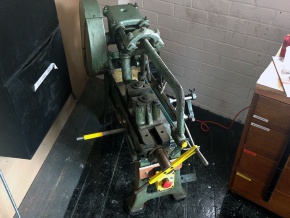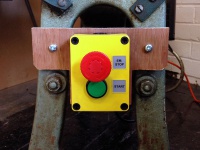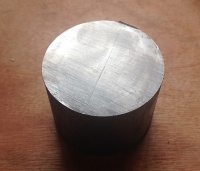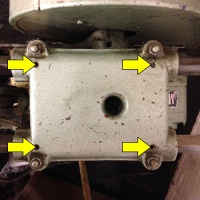Power Hacksaw: Difference between revisions
m Equipment template |
mNo edit summary |
||
| Line 1: | Line 1: | ||
{{Equipment | {{Equipment | ||
| title = Power Hacksaw | | title = Power Hacksaw | ||
Revision as of 00:12, 1 March 2016
 | |
| Equipment Information | |
|---|---|
| Status | Unknown |
| Manufacturer | Rapidor |
| Model | Unknown |
| Hackspace Information | |
| Induction Required | No |
| Card RFID Enabled | No |
| Owner | Aidan |
The Basics
This Rapidor Power Hacksaw, or donkey saw, is for those times when you really don't want to cut through a thick chunk of steel using a manual hacksaw. Cutting with this machine instead is slow, but effort free and relatively precise.
An adjustable end-stop allows for reasonably precise repeated cuts and is adjusted from both sides of the machine body.
It is for cutting both ferrous and non-ferrous metals as well as plastic. Wood is better suited elsewhere because it will soak up the grease and oil that this machine spreads everywhere.
Please clean up the swarf created after you have finished cutting - wiping out the tray now is much easier than chipping it off in a few months time!
Safety

The blade body will not protrude past the yellow section of the vise handle.
- Keep away from the moving blade body, especially when starting.
- Do not press down on the blade body to make it cut faster.
- Do not reach underneath the propped blade body.
- Do not remove the safety covers.
- Keep fingers clear of pinch points.
- Stop the machine before making adjustments.
- Cut metal will be hot.
Making a cut

If you are unsure how to use this machine, please ask someone who does.
- Secure your work-piece in the jaws of the vise and tighten securely.
- Plug in the saw (orange cable) and wait a few seconds for the VFD to boot up.
- Ensure the E-stop button is not pressed in (rotate clockwise to unlock if it is).
- Making sure that your head is not in the way of the blade body press the green start button.
- There is a two second delay to starting - this gives you ample time to get out of the way.
- The machine will turn itself off when the cut is completed.
Lubrication

DO NOT drip oil onto the VFD/power supply near the rear of the machine, next to the motor. If you do, definitely don't turn it on.
There are four oil points on the top of the saw body which lubricate the guide rails. Place a drop of oil into each of these holes each time you use the saw to keep it running smoothly. Through the large centre hole there is access to the cam lubrication point which should be oiled regularly.
Finally, there is an oil point on each axle bearing.
There is a cam operated coolant pump built in to the saw which, when used, will prolong the life of the blades. Take note of where the coolant line is pointing (and adjust if necessary) before you turn the saw on!
We are currently looking into the best lubricant to use with this pump for the most common cutting situations.
Replacing the blade
You may need to change the blade if it breaks or you are cutting thinner/thicker material. It is held in place by 3/16" hex bolts on the blade body. You might need to tighten or loosen the yellow nut (with roll pin) on the end. A good rule of thumb is this: the thinner the work you are cutting, the more teeth you need.
- Blades are 14" long, 1.25" high.
- Thickness (kerf) is typically 1.5 mm.
- Spare/different blades are kept in the groove to the left of vise.
Replacement blades are available from a variety of places, including Cromwell Tools.